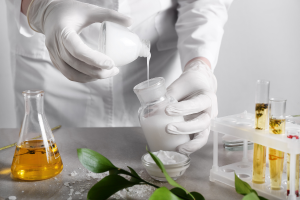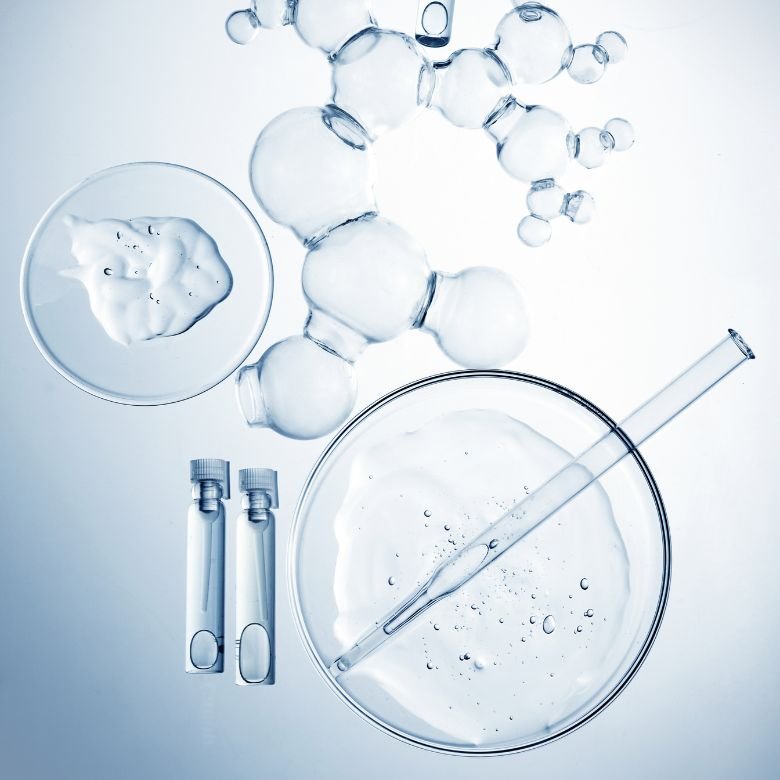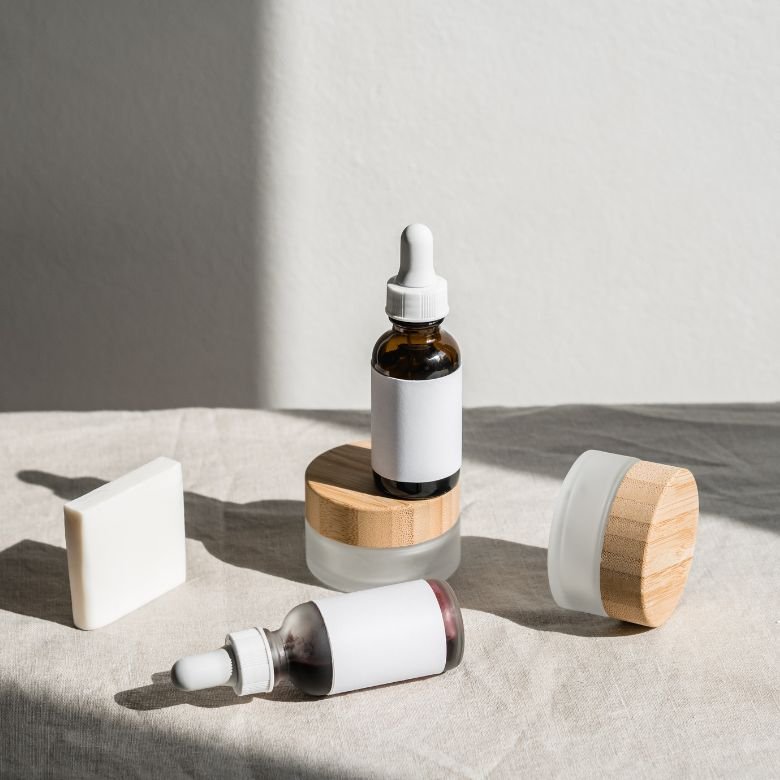Every year we are becoming more and more conscious consumers. We carefully read the labels of the products we choose and engage in discussions about artificial food additives and personal care products. One particularly controversial topic is preservatives in natural cosmetics. Is their use necessary and should we be afraid of them? We encourage you to read!

What are preservatives in cosmetics?
Let us start by explaining what preservatives are used in cosmetics. These include substances with antimicrobial effects, i.e. antibacterial and antifungal. Their use is aimed at extending the life of the product and keeping it in the best possible condition. This is because, for example, its consistency can change over time, especially after opening and contact with the skin. The inhibition of harmful microbial activity also has an impact on the cosmetic’s fragrance.
- The proliferation of bacteria, fungi and mould in products can be very dangerous to our health. This is because they produce harmful toxins that cause irritation and inflammation, among other things.
- Microorganisms appear in cosmetics because the main ingredient in many of them is water, which creates ideal living conditions for microorganisms. Their presence is also related to the use of the product itself, e.g. dipping fingers into the product.
The use of preservatives in cosmetics is therefore necessary in most cases. Paradoxically, it is natural cosmetics that are particularly prone to the harmful effects of bacteria and fungi, which is why additional substances must be included in their composition. Without preservatives in cosmetics, we would be at much greater risk of irritation and infection.
Can preservatives used in cosmetics prove dangerous after all? It is difficult to give a definite answer to this question, as much depends on their type and the individual needs and possible allergies of each consumer.
We describe the breakdown of preservatives later in this article. However, it is worth mentioning here that several techniques are currently being used to reduce the concentration of preservatives in cosmetics. Such measures reduce the risk of allergies and irritation. One is to add natural excipients, such as essential oils, to cosmetics. New research is also constantly being conducted. Manufacturers also endeavour to take care of the quality and type of packaging to give them bacteria-inhibiting properties. A cream in a tube, for example, is a good solution, as the emulsion remaining in such a container does not come into direct contact with our skin.
Learn about the types of preservatives in cosmetics
Preservatives used in cosmetics can be divided into synthetic and natural.
Synthetic preservatives in cosmetics, produced by chemical reactions, are often the most potent. The way they are used is strictly defined by the Regulation of the European Parliament and the Council and by the documents of the organisations that certify the substances.
The second group are natural preservatives in cosmetics. These are substances that exhibit antibacterial and antifungal effects, such as essential oils. We often underestimate their properties, while the efficacy of many of them — sometimes rivalling synthetic preservatives — is confirmed by numerous studies. This is why tea tree, clove or cinnamon oil is included in the formulation of many natural cosmetics.
Currently, the most common preservatives in cosmetics are:
- parabens,
- sodium benzoate,
- potassium sorbate,
- salicylic acid,
- alcohol, including benzyl alcohol,
- essential oils.
Another specific preservative used in cosmetics is phenoxyethanol, or phenethyl alcohol. It exhibits strong bactericidal activity and is controversial because of the risk of causing allergies and irritation if the substance is used in too high a concentration (the acceptable standard is <1%). Like many other alcohols, it also shows moisturising properties.
The use of only natural preservatives can be evidenced, for example, by the short shelf life of the product, and sometimes also by its texture. A safer choice, however, is a combination of essential oils and other preservatives in low concentrations.
Substances with a bactericidal effect also include lactic acid and caprylic acid.
The composition of cosmetics can tell you a great deal about their performance and the practices of the manufacturers; you will get much more information from it than from advertisements or product descriptions.

Preservatives in cosmetics — examples you will most often encounter
You already know which preservatives in cosmetics you can find in the ingredients of individual products. They generally fall into several groups:
- alcohols and their derivatives, including ethyl and benzyl alcohol,
- acids, e.g. benzoic, lactic, salicylic; their effectiveness is usually dependent on the concentration of the substance in the cosmetic,
- parabens, which are hidden under names such as methylparaben, butylparaben or aseptin,
- natural substances, primarily essential oils, e.g. of cinnamon, cloves, rosemary or tea tree, usually combined with other preservative ingredients.
It is important to remember that not all preservatives in cosmetics, despite belonging to the same group, have the same properties. For example, some alcohols have a moisturising effect, while others have a drying effect. Therefore, take into account your skin type and possible allergies when choosing the right product, and contact a specialist if necessary.
Preservatives in cosmetics and their properties
The raw materials for natural cosmetics also include preservatives. Why do we need preservatives in cosmetics? It turns out that they perform a number of important functions. The most important of these is, of course, the antimicrobial action. Other properties of preservatives in cosmetics include:
- prolonging the shelf life of the product,
- inhibiting the growth of bacteria and fungi, thereby preventing the formation of the toxins they excrete,
- maintaining the right consistency, appearance and odour of the emulsion.
The cosmetics you use every day owe much of their form to preservatives. Rather than negating their use, it is therefore worth choosing the best among them. Always be guided by the type of preservatives in cosmetics and their concentration to take care of your skin.

Are preservatives in cosmetics safe?
In the aforementioned Regulation of the European Parliament and of the Council of 30 November 2009, we find a catalogue of substances authorised for use in cosmetics, including an index of preservatives. The document also provides guidance on the tests to be carried out, reports to be submitted and production control. According to these, before a product is placed on the market, an assessment of its impact on consumer health, in the form of a safety report, is required.
For a preservative to be approved for use, it should meet a number of requirements. Substances with this effect must be:
- effective at low concentrations,
- water-soluble,
- active against as many harmful micro-organisms as possible,
- non-toxic and non-allergenic/irritant,
- chemically stable.
In addition, preservatives in cosmetics must not impair the action of other ingredients in the formulation or disrupt the balance of the skin’s microflora. If you pay attention to the composition of the product and choose preservatives that have been dermatologically tested, you significantly reduce the risk of them negatively affecting your skin. The only exception to this is individual allergies to particular cosmetic ingredients, which should always be taken into account when selecting products at the chemist.
Despite the many regulations, safeguards and dermatological tests, there are a few cases where preservatives in cosmetics prove to be harmful, especially for those with sensitive, allergy-prone skin. The symptoms you should look out for are:
- urticaria,
- acne,
- discolouration at the site of cosmetic application,
- any irritation.
If you notice them, discontinue use of the cosmetic and contact a specialist, preferably a dermatologist, as well as the manufacturer, who should collect information on any adverse phenomena occurring after using the products offered. Following reports of such reactions, Cosmetics Europe, an advisory body to the European Commission, is commissioning additional research. If their results are of concern, then the permissible concentration of the preservative in the cosmetic is reduced and, in extreme cases, the use of the substance becomes banned.
On the PCC Group’s Product Portal you will find a lot more information on the cosmetic intermediates and the manufacture of cosmetics. Familiarise yourself with them to make informed purchasing decisions!
- Julia Bulska, Konserwanty w kosmetykach, https://www.sienkiewicz.czest.pl/dokumenty/06.2022%20talenty/praca-konserwanty-w-kosmetykach.pdf
- Michalina Adaszyńska, Maria Swarcewicz, Olejki eteryczne jako substancje aktywne lub konserwanty w kosmetykach, Wiadomości chemiczne, nr 66 (2022)
- https://www.kosmopedia.org/bezpieczenstwo/czarna-lista-skladnikow-kosmetycznych/kosmetyki-i-konserwanty/
- https://single-market-economy.ec.europa.eu/sectors/cosmetics/cosmetic-products-specific-topics/preservatives_en
- https://echa.europa.eu/cosmetics-preservatives